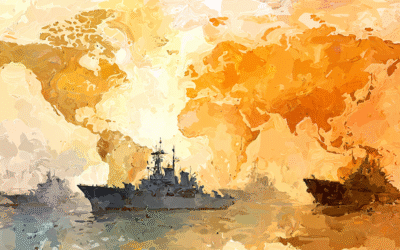In a thought-provoking article, Curses, Blessings, Walkouts, and Workouts in the World’s Wars, Dr. Colin Benjamin frames the global crossroads we stand at: do we continue along the path of curses, defined by division, conflict, and environmental degradation? Or can we consciously choose the path of blessings—peace, cooperation, and a new world order that supports shared prosperity?
This framework of “curses versus blessings” serves as a profound reflection on the decisions humanity faces today. Dr. Benjamin’s call for a transformative approach to global governance opens a crucial dialogue about how we institutionalize peace in ways that go beyond what we have attempted in the past. He imagines a Global Assembly of People’s for Peace and Prosperity (GAPPP), an ambitious initiative that, if realized, could radically shift how we engage with conflict resolution, sustainability, and governance.
As someone deeply influenced by Dr. Benjamin’s mentorship and wisdom, his ideas have shaped much of my thinking on peacebuilding. The GAPPP proposal resonates with my long-held belief that institutionalizing peace should be as deliberate and robust as institutionalizing military forces or economic policies. In this article, I will extend his vision, exploring how GAPPP can materialize, how it aligns with indigenous sovereignty, cultural preservation, environmental diplomacy, and how it could effectively turn curses into blessings.
Decentralizing Global Governance: Moving Beyond Power Concentrations
One of the most urgent reforms in global governance is the redistribution of power away from traditional centers in the Global North. Currently, the UN Security Council—the ultimate arbiter of international peace and security—is disproportionately influenced by the interests of five permanent members (P5). While these nations wield considerable economic and military power, their dominance has stifled the voices of smaller nations, indigenous groups, and the Global South.
The proposal to relocate the Security Council under the umbrella of GAPPP and station it in the Southern Hemisphere is a revolutionary step. It symbolically represents a commitment to decentralizing global governance and addressing long-standing geopolitical imbalances. Imagine the Security Council convening in cities like Nairobi or Buenos Aires, far from the corridors of power in New York, Moscow, or London. This move would open new spaces for underrepresented nations—particularly those within the Non-Aligned Movement (NAM)—to actively shape international policy.
To make this work, we could introduce a rotating leadership model where nations from different global regions, particularly from NAM countries, take turns leading the Security Council’s agenda. These leaders could prioritize issues that have long been neglected by the current permanent members—topics such as climate justice, equitable development, and conflict resolution rooted in diplomacy rather than military force. The current power balance is overdue for a recalibration, and this restructuring could be a powerful first step in enabling more just and equitable global decision-making.
Incorporating indigenous voices into the Security Council would be another significant move. Indigenous groups, often marginalized by nation-states, possess unique cultural and environmental knowledge that could contribute to more effective governance. For example, indigenous leaders from the Amazon Basin could advocate for sustainable policies that preserve their territories, challenging the destructive extractive industries that threaten the world’s most biodiverse ecosystems.
Reframing Indigenous Sovereignty Through ILO 107
One of the most exciting possibilities in the GAPPP framework is the potential to expand the role of ILO Convention 107—a historical framework that focused on integrating indigenous peoples into mainstream societies. However, the goal is no longer assimilation; it’s self-determination. Indigenous peoples must have a seat at the table where their sovereignty is recognized, not just in theory but in practice. GAPPP offers a pathway to reframe ILO 107, allowing it to focus on the protection and promotion of indigenous rights.
Indigenous sovereignty goes beyond token representation. It requires the full integration of indigenous governance systems into broader political frameworks, allowing them control over their land, resources, and development. In Australia, this is an ongoing discussion, particularly with regard to land rights and environmental stewardship. Indigenous people have been managing the land for tens of thousands of years, and their wisdom is crucial in today’s discussions around sustainability and climate change.
Under GAPPP, indigenous nations should be able to directly negotiate international agreements that impact their territories. For example, nations like the Sámi people of Northern Europe—whose way of life is threatened by climate change—could be recognized as sovereign actors with the ability to influence policies on Arctic conservation. Their participation would not only validate their rights but also offer innovative solutions rooted in traditional ecological knowledge.
UNESCO’s Role in Cultural Preservation: A Bridge to Peace
Culture is not a side issue in peacebuilding; it’s central. Conflict often stems from cultural erasure, domination, or disrespect, and until we address these root causes, peace efforts will remain fragile. Under GAPPP, UNESCO could expand its role beyond the protection of world heritage sites and take on the challenge of cultural preservation as a peacebuilding tool.
Consider the historical division in Cyprus, where tensions between Greek and Turkish Cypriots have persisted for decades. GAPPP could foster cultural corridors—safe spaces for cultural exchange and dialogue—enabling both communities to share their histories and traditions, not as a means of dominance but as a way of healing and reconciliation. By emphasizing mutual respect for cultural identities, these corridors could help transform regions of deep-seated animosity into models of peaceful coexistence.
Additionally, the GAPPP framework could support the creation of cultural councils that bring together representatives from different cultural backgrounds to discuss and mediate conflicts, emphasizing that cultural diversity is a strength rather than a liability. This global initiative would cultivate a shared sense of global citizenship, where the protection of cultural heritage is understood not just as preservation but as a cornerstone of lasting peace.
Establishing Multicultural Peace Zones and Life Force
Building on Dr. Benjamin’s reference to global figures like Greta Thunberg and Nelson Mandela, the concept of Multicultural Peace Zones takes center stage. These zones, located in regions historically prone to conflict, would operate under the auspices of GAPPP as havens of ecological, economic, and cultural cooperation. The idea is not new in principle—demilitarized zones like the Panmunjom Peace Village along the Korean Demilitarized Zone (DMZ) offer a glimpse of what could be—but GAPPP takes this further by incorporating a holistic vision of peace that includes environmental stewardship.
These peace zones would be governed by multicultural peacekeeping forces trained not only in conflict resolution but also in environmental management and sustainable development. For instance, the creation of a peace zone in the Great Lakes region of Africa, where resource-driven conflicts over minerals have caused immense human suffering, could involve international teams working alongside local communities to develop sustainable mining practices, fair trade agreements, and environmental conservation projects.
In a time when the global climate crisis is exacerbating conflicts, GAPPP could champion environmental peace zones, where neighboring countries collaborate to manage shared resources such as rivers, forests, or migratory paths. Take the Nile Basin as an example—GAPPP could facilitate agreements between Ethiopia, Egypt, and Sudan to share water resources equitably, while developing joint sustainability projects to preserve the ecosystem for future generations.
Peace Corridors and Transitional Regions: Reimagining Conflict Zones
Few areas of the world seem more permanently mired in conflict than regions like Kashmir, Crimea, or the Middle East. GAPPP’s vision of transforming these regions into Peace Corridors is bold, but boldness is exactly what is required. These corridors would not be simple ceasefire zones; they would serve as economic and cultural hubs, designed to shift the identity of these places from conflict zones to models of coexistence and collaboration.
A Peace Corridor in Kashmir, for example, could include economic collaboration between India and Pakistan, joint environmental projects to preserve the region’s fragile ecology, and cultural exchanges that promote dialogue between Hindu, Muslim, and Buddhist communities. This wouldn’t solve the territorial disputes overnight, but it could transform the nature of the conflict by demonstrating that cooperation benefits all parties involved. The Peace Corridor model could also include joint education initiatives, where children from all sides of the conflict learn together, building empathy and understanding from a young age.
Environmental Diplomacy and Peace Corridors
The environmental dimension of peacebuilding is often overlooked, yet it is critical in a world increasingly strained by climate change. Resource scarcity—whether it be water, land, or energy—can drive conflicts, but it can also drive cooperation. GAPPP’s environmental peace corridors could focus on shared resource management, where countries collaborate to protect fragile ecosystems while fostering sustainable development.
Regions like the Amazon Rainforest or the Arctic Circle, where environmental degradation has global consequences, would benefit from a joint management model that emphasizes cooperation over competition. Indigenous groups, local governments, and international actors could work together under GAPPP to develop strategies that ensure both the environmental and economic sustainability of these areas. Transnational environmental stewardship could become a cornerstone of global peace, with the shared recognition that the Earth’s resources belong to all humanity—not just to those with the power to exploit them.
The International Joint Conflict Commission (IJCC): Neutrality and Conflict Prevention
Underpinning the GAPPP framework would be the creation of an International Joint Conflict Commission (IJCC), a body designed to prevent and mediate conflicts before they escalate into war. The IJCC would operate with neutrality as its guiding principle—free from the geopolitical biases that have hampered the effectiveness of the current UN Security Council. This commission would include representatives from civil society, indigenous groups, and environmental experts, ensuring that its approach to conflict resolution is holistic and inclusive.
One of the IJCC’s most important roles would be in the area of conflict prevention. By developing a global early warning system, the IJCC could identify potential conflicts before they ignite, offering mediation services and facilitating dialogue between parties at odds. This would be especially critical in regions experiencing environmental degradation, where competition over dwindling resources could lead to violent conflict. The IJCC would work closely with GAPPP’s peace zones and corridors to implement conflict-sensitive development policies, ensuring that economic growth does not come at the expense of peace.
Blessings Over Curses
As Dr. Colin Benjamin so eloquently put it, we are at a global crossroads between curses and blessings. The Global Assembly of People’s for Peace and Prosperity (GAPPP) represents a bold, imaginative step towards a world where peace is institutionalized, indigenous rights are respected, and environmental diplomacy is at the heart of conflict resolution. This vision is not without its challenges, but if we are to turn curses into blessings, we must be willing to rethink how global governance, peace, and prosperity are intertwined.
The world needs GAPPP, not as an idealistic fantasy but as a concrete, actionable framework for creating lasting peace. With the involvement of marginalized voices, indigenous leaders, and a reformed global governance structure, GAPPP could become the most transformative peace initiative of the 21st century. Now is the time to act, to choose blessings over curses, and to build a world where peace is not just a dream but a shared reality.










0 Comments